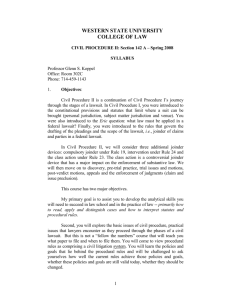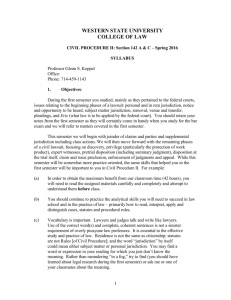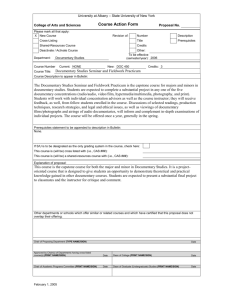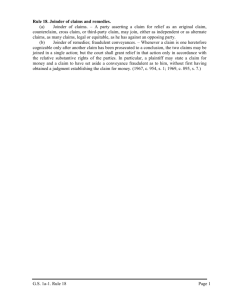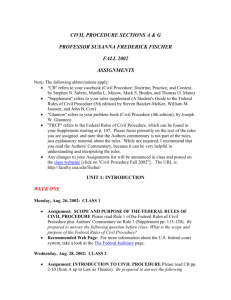civil procedure ii - Western State College of Law
advertisement
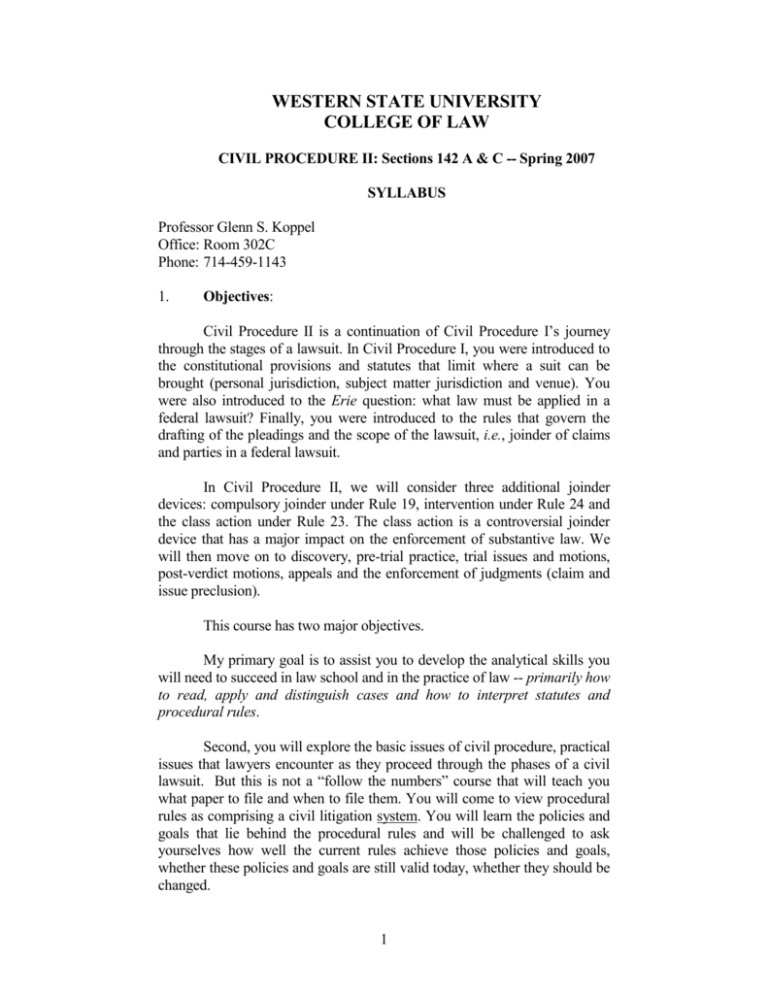
WESTERN STATE UNIVERSITY COLLEGE OF LAW CIVIL PROCEDURE II: Sections 142 A & C -- Spring 2007 SYLLABUS Professor Glenn S. Koppel Office: Room 302C Phone: 714-459-1143 1. Objectives: Civil Procedure II is a continuation of Civil Procedure I’s journey through the stages of a lawsuit. In Civil Procedure I, you were introduced to the constitutional provisions and statutes that limit where a suit can be brought (personal jurisdiction, subject matter jurisdiction and venue). You were also introduced to the Erie question: what law must be applied in a federal lawsuit? Finally, you were introduced to the rules that govern the drafting of the pleadings and the scope of the lawsuit, i.e., joinder of claims and parties in a federal lawsuit. In Civil Procedure II, we will consider three additional joinder devices: compulsory joinder under Rule 19, intervention under Rule 24 and the class action under Rule 23. The class action is a controversial joinder device that has a major impact on the enforcement of substantive law. We will then move on to discovery, pre-trial practice, trial issues and motions, post-verdict motions, appeals and the enforcement of judgments (claim and issue preclusion). This course has two major objectives. My primary goal is to assist you to develop the analytical skills you will need to succeed in law school and in the practice of law -- primarily how to read, apply and distinguish cases and how to interpret statutes and procedural rules. Second, you will explore the basic issues of civil procedure, practical issues that lawyers encounter as they proceed through the phases of a civil lawsuit. But this is not a “follow the numbers” course that will teach you what paper to file and when to file them. You will come to view procedural rules as comprising a civil litigation system. You will learn the policies and goals that lie behind the procedural rules and will be challenged to ask yourselves how well the current rules achieve those policies and goals, whether these policies and goals are still valid today, whether they should be changed. 1 “Civil Procedure” is highly controversial these days. The civil litigation system in the U.S. is under attack by critics who assert that there is a “litigation explosion” of baseless lawsuits which has clogged our courts and denied justice to all but the wealthiest litigants. These critics advocate more liberal use of summary judgment and pre-trial conferences to de-rail litigation out of court. Recently, Congress enacted the Class Action Fairness Act to cut back on class actions, a joinder device intended to empower consumers who otherwise might be unable to enforce their rights in court. Others argue that the “litigation explosion” is a myth created by wealthy “repeat-player” defendants to justify “fixing” the rules to make it easier to dismiss claims against them. Discovery is another bone of contention. Intended originally as a reform measure designed to level the playing field between rich and poor litigants, discovery - many experts believe - is out of control, abused by some litigators to achieve unfair tactical advantage in litigation. As you work your way through this course, ask yourself whether the federal rules have achieved the goals of securing the “just, speedy, and inexpensive determination of every action.” (Rule 1) 2. Required Texts: Civil Procedure – Cases, Materials and Questions, Freer & Perdue, Fourth Edition. Federal Rules of Civil Procedure 2004, Foundation Press Harr, A Civil Action, Vintage Books, 1996 Grossman & Vaughn, A Documentary Companion to A Civil Action Foundation Press, 2002 3. Recommended: Civil Procedure – Examples & Explanations, Joseph W. Glannon; Fourth Edition, Aspen Law & Business The Glannon Guide to Civil Procedure, Joseph W. Glannon, Aspen Publishers. 2 4. "In-Class" Methodology: The centerpiece of this course will be Federal Rules of Civil Procedure [hereinafter, “F.R.C.P.”] which is the code of procedure applicable in civil litigation in federal court. However, Civil Procedure law is derived from a wide variety of primary legal authority besides the F.R.C.P. For example, the right to a civil jury trial flows from the Seventh Amendment to the U.S. Constitution. The right to appeal a judgment is, in part, defined by congressional statute (28 U.S.C.§§1291 and 1292). But even where an F.R.C.P. or statute or constitutional provision governs a particular procedural issue, the relevant text must be interpreted by courts on a case-bycase basis. Therefore, although this course deals with “procedural rules," we will, nevertheless, heavily employ the same “case method” with which you have already become somewhat familiar in your “substantive” courses (i.e., contracts and torts). To prepare for class, you must read the assigned materials carefully and brief all cases (not including note cases). Book briefing is not acceptable. When, during the course of your assigned reading, you encounter references to an F.R.C.P. or a federal statute or a constitutional provision, you are required, as part of your preparation for class, to look up these legal sources in your supplement and read them carefully. Also, most of the F.R.C.P.’s in the supplement are followed by Advisory Committee Notes, which is the F.R.C.P. equivalent of the “legislative history” behind the rules. These Notes are a valuable resource to help you to understand the rules and you are, therefore, required, as part of your preparation for class, to read these carefully as well. PLEASE TAKE NOTE! Several of the F.R.C.P.s were recently amended effective December 2006. You can access the amended rules at the following website: www.supremecourtus.gov/orders/courtorders/frcv06p.pdf. When you are assigned an F.R.C.P., you are responsible for checking to see whether that rule has been amended and, if so, for reading that amended rule and knowing the changes the amendment made to the rule. In addition to the recent federal rules amendments, the Freer & Perdue casebook has been updated by an online Supplement which is available at http://www.lexisnexis.com/lawschool/study/texts/#CivilProcedure. For each week’s reading assignment, you are responsible for consulting this Supplement to determine whether the assigned pages have been updated. 3 In addition to the required and recommended texts, there is another learning resource available to you at your option. This resource is a set of computer-aided exercises known as “CALI” that is located in the computer lab located in the Library. You can perform these exercises in the computer lab or make copies for your home use. The CALI exercises cover a variety of civil procedure topics and can be a valuable way to strengthen your ability to deal intelligently and creatively with the issues and concepts explored in class. Maximum benefit can be derived by performing these exercises in teams of two or more students. 5. Exams and Grading There will be a multiple choice mid-term and a final examination consisting of multiple choice questions, short answer questions and an essay question. Each student will receive a numeric final course grade which will consist of the sum of 15% of the mid-term grade and 85% of the final examination grade. If a student is repeatedly unprepared, that student's final course grade will be subject to being reduced as a penalty; see infra "Classroom Participation". 6. Classroom Participation Legal education is a cooperative venture. Each of you must be prepared to participate in class on a regular basis. If you are unprepared, you may be deemed “absent” for that class session, at my discretion. PLEASE NOTE: THERE IS A SIGNIFICANT DIFFERENCE BETWEEN BEING UNPREPARED AND BEING UNABLE TO ANSWER A PARTICULAR QUESTION. No one knows the answer to every law-related question. You will not be down-graded for venturing an incorrect answer so long as it is clear that you have read the assigned material and briefed the assigned cases. 7. Attendance & Decorum Successful completion of this course is dependent upon satisfaction of the W.S.U. Attendance Policy which is reprinted in the Student Handbook. I will take attendance at the beginning of each class. If you arrive late or depart early you will be marked absent for that session. Late arrivals must not sign the sign-in sheet. IF YOU MISS MORE THAN FOUR (4) CLASSES DURING THE SEMESTER YOU WILL RECEIVE A GRADE OF "F" AND WILL NOT BE PERMITTED TO ATTEND SUBSEQUENT CLASSES. 4 ALSO BE AWARE THAT, PURSUANT TO W.S.U.'S ATTENDANCE POLICY, STUDENTS CANNOT MAKE UP AN ABSENCE BY ATTENDING ANOTHER PROFESSOR'S CLASS. Students' leaving and returning to their seats while class is in session is a major distraction for other students as well as for myself. Therefore, once class begins, students may not leave the classroom prior to the end of the class session unless you have notified the Dean of Students in advance that you have a particular physical condition that renders you unable to comply with this rule. Violation of this rule may be deemed an "early departure" for which a student may be marked absent 8. Seating Chart A seating chart will be distributed at the beginning of the second class session. Please print your name legibly in the seat you choose for your permanent seat. If you wish to change your seat, please notify me so that I can make the appropriate changes on the chart. 9. Office Hours: Please make appointments through the Faculty Appointments Book located at the receptionist desk on the third floor. My office hours will be posted in this book. If you cannot make a scheduled appointment, please notify me or my secretary that you are canceling your appointment as soon as possible so that another student can see me during that time slot. I will also be available the rest of the week as time permits. 10. Course Web Page: The course will have its own webpage on Lexis-Nexis’ Blackboard platform. You will need a Lexis ID number to access the webpage. To access the webpage, go to http://webcourses.lexisnexis.com/. The course webpage includes chat subgroups, instructional objectives for every topic that is a part of this course, downloadable outlines of every topic to help you organize your lecture notes, links to the online quizzes, “think aloud” demonstrations of the legal analysis skills you are expected to develop in this course and other helpful information and links. Click on the “Course Information” button to learn about the course webpage and how you can use it to enhance your learning. 5 Reading Assignments The Scope of Litigation: Joinder of Parties and Claims Continued from Civil Procedure I WEEK 1 I. Compulsory Joinder (Necessary and Indispensable Parties) Required: F&P1 769 – 781 Rule 19 CALI (Computer Aided Legal Instruction) Lesson: Joinder of Claims and Parties – located in the Course Documents folder of the Civil Procedure II Course Website. II. Intervention Required: F&P 781 – 786 Rule 24 III. Interpleader Required: F&P 787 – 798 [including Pan American Fire & Casualty Co. v. Revere, and Notes 1 – 7] Rule 22; 28 U.S.C. §§1335, 1397, and 2361 WEEK 2 IV. The Class Action A. Introduction Required: F&P 806-810. Also read the following law review article: John Bronsteen and Owen Fiss, The Class Action Rule, 78 Notre Dame Law Review 1419 (August 2003). B. Constitutional Considerations Required: F&P 810 – 817 C. Mechanics of Rule 23 Required: F&P 817-835; A Civil Action – Documentary Companion 187 – 188 (Questions 1 – 4, 5). Rule 23 D. Jurisdictional Considerations Required: F&P 835 – 844 1 “F&P” refers to Freer and Perdue, CIVIL PROCEDURE (FOURTH EDITION) 6 Discovery: Preparation for Trial, Summary Judgment or Settlement WEEK 3 I. Introduction Required: F&P 397 – 400; Amended federal rules regarding e-discovery effective December 2006 – available at http://www.uscourts.gov/rules/EDiscovery_w_Notes.pdf; CALI Exercise – “The Discovery Game”2 Recommended: Glannon – Examples & Explanations3 327 – 328; The Glannon Guide4 311 – 312 II. Discovery Devices Recommended: Glannon – Examples & Explanations 351 – 387; The Glannon Guide 336 – 356 A. Mandatory Initial Disclosures Required: F&P 400 – 401 Rule 26(a)(1) B. Depositions Required: F&P 401 – 403; A Civil Action – Documentary Companion 286 – 297, 297 - 300 (“ Facher Talks Shop”), 311 – 314. Rules 27, 28(a) and (c), 30, 31, and 32 C. Interrogatories Required: F&P 403 – 404; A Civil Action – Documentary Companion 245 – 276. Rule 33 D. Production of Documents and Things Required: F&P 404 Rule 34 E. Medical Examination 2 There are several versions of the Discovery Game available in the Library. Any one of these versions may be played to satisfy this assignment. 3 “Glannon – Examples and Explanations” refers to Joseph W. Glannon, CIVIL PROCEDURE – EXAMPLES AND EXPLANATIONS (Fourth Ediciton). 4 “The Glannon Guide” refers to Joseph W. Glannon, THE GLANNON GUIDE TO CIVIL PROCEDURE. 7 Required: F&P 404 – 405; A Civil Action – Documentary Companion 335 – 347. Rule 35 F. Requests for Admission Required: F&P 405 – 406; A Civil Action – Documentary Companion 377 – 389. Rule 36 III. Scope of Discovery Recommended: Glannon – Examples & Explanations 327- 349; The Glannon Guide 312 – 333 A. General Scope; Proportionality Limits Required: F&P 406 – 415; Zubulake v. UBS Warburg, 217 F.R.D. 309, 2003 U.S. Dist. LEXIS 7939 (May 13, 2003) Rule 26(b)(1) and (2); A Civil Action – Documentary Companion 389 – 191, 195 – 199 (including Questions 1 and 2). WEEK 4 B. Privilege Required: F&P 415 – 419. C. Work Product Required: F&P 419 – 437; A Civil Action – Documentary Companion 205 – 209 (including Questions 1 – 7). Rule 26(b)(3) WEEK 5 D. Experts Required: F&P 437 – 448; A Civil Action – Documentary Companion 216 – 230, 363 – 364 [Note 4: Documentary Discovery From a Nontestifying Examining Physician], 375 – 376 [Note 5: Documentary Discovery from Testifying Examining Physicians]. Rules 26(a)(2) and 26(b)(4) E. Review Problem: F&P 448 – 449 IV. Timing, Pretrial Disclosures, and Conferences Required: F&P 450 – 456 V. Discovery Sanctions Required: Rules 26(g) and 37 8 Judgment and Beyond WEEK 6 I. The Right to a Jury Under the Seventh Amendment Required: F&P 477 – 500; A Civil Action – Documentary Companion 598 – 599 [Notes 1 – 4] II. Pre-Trial Disposition A. Default Judgment Required: F&P 369 – 372 Rules 54(c) and 55 B. Involuntary Dismissal Required: F&P 359 – 361 Rule 41(b) C. Voluntary Dismissal Required: F&P 356; A Civil Action – Documentary Companion 555-556. Rule 41(a) WEEKS 7 & 8 D. Summary Judgment Required: F&P 531 – 558; A Civil Action – Documentary Companion 557 – 580; also read the following law review article: Glenn S. Koppel, The California Supreme Court Speaks Out on Summary Judgment In Its Own “Trilogy” of Decisions: Has the Celotex Era Arrived?, 42 Santa Clara L. Rev. 483 (2002);. Rule 56 Recommended: Glannon – Examples & Explanations 389 – 408; The Glannon Guide 357 – 376 WEEKS 9 & 10 III. Trial Disposition Recommended: Glannon – Examples & Explanations 409-448; The Glannon Guide 377-397 A. Judgment as a Matter of Law Required: F&P 559 – 568 Rule 50 9 B. New Trial and Relief from Judgment Required: F&P 569 – 578 Rules 59 and 60 Recommended: The Glannon Guide 399-419 WEEKS 11 - 13 IV. Preclusive Effects of Prior Judgments A. Introduction Required: F&P 651 – 653 B. Claim Preclusion (Res Judicata) Required: F&P 653 – 674 Recommended: Glannon – Examples & Explanations 451-483; The Glannon Guide 421-440 C. Issue Preclusion (Collateral Estoppel) Required: F&P 674 – 705 Recommended: Glannon – Examples & Explanations 485-519; The Glannon Guide 441-461 D. Problems of Federalism Required: F&P 705 – 710 WEEK 14 V. Appeal Required: F&P 845 – 849; 856 – 875 10
